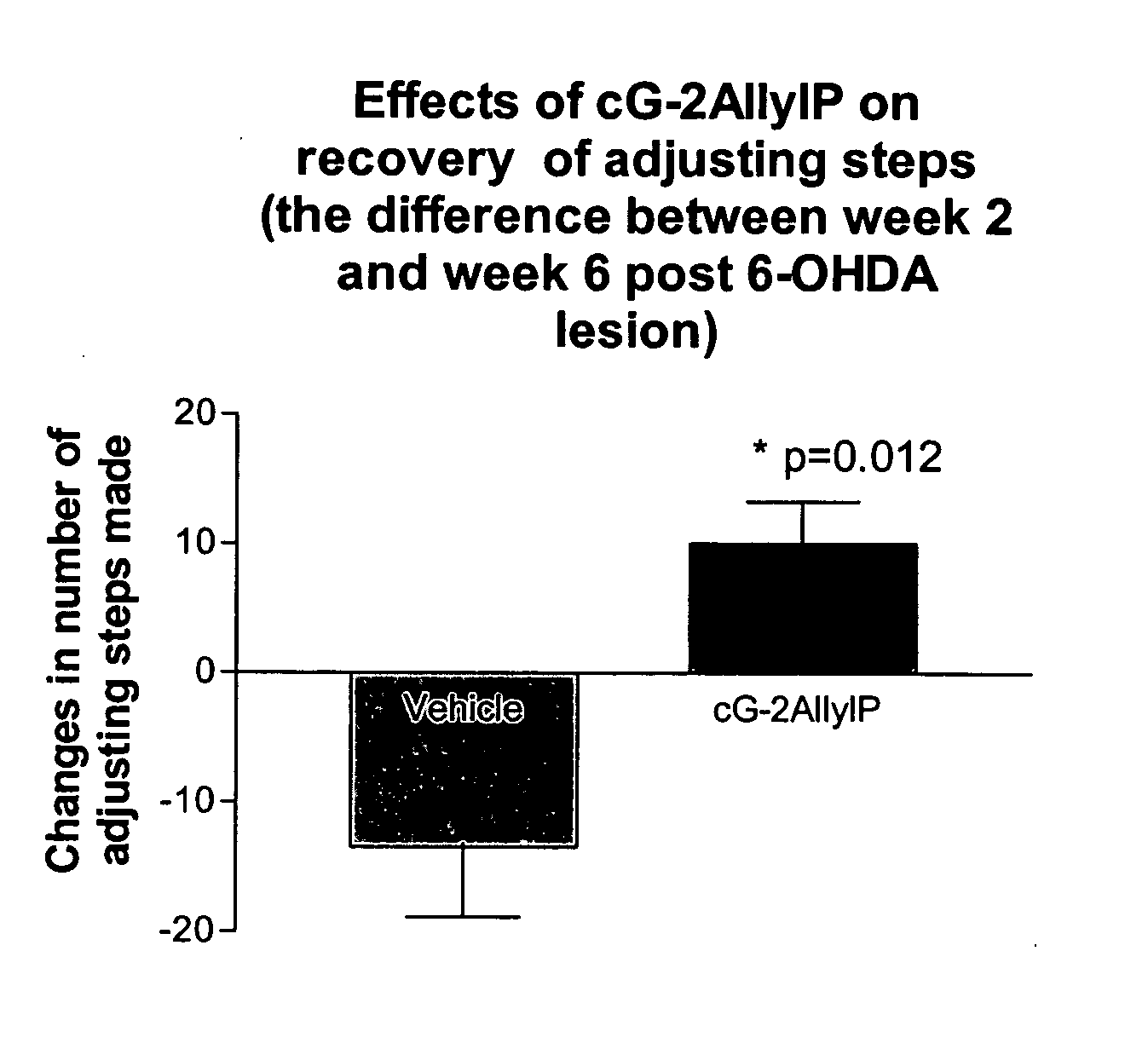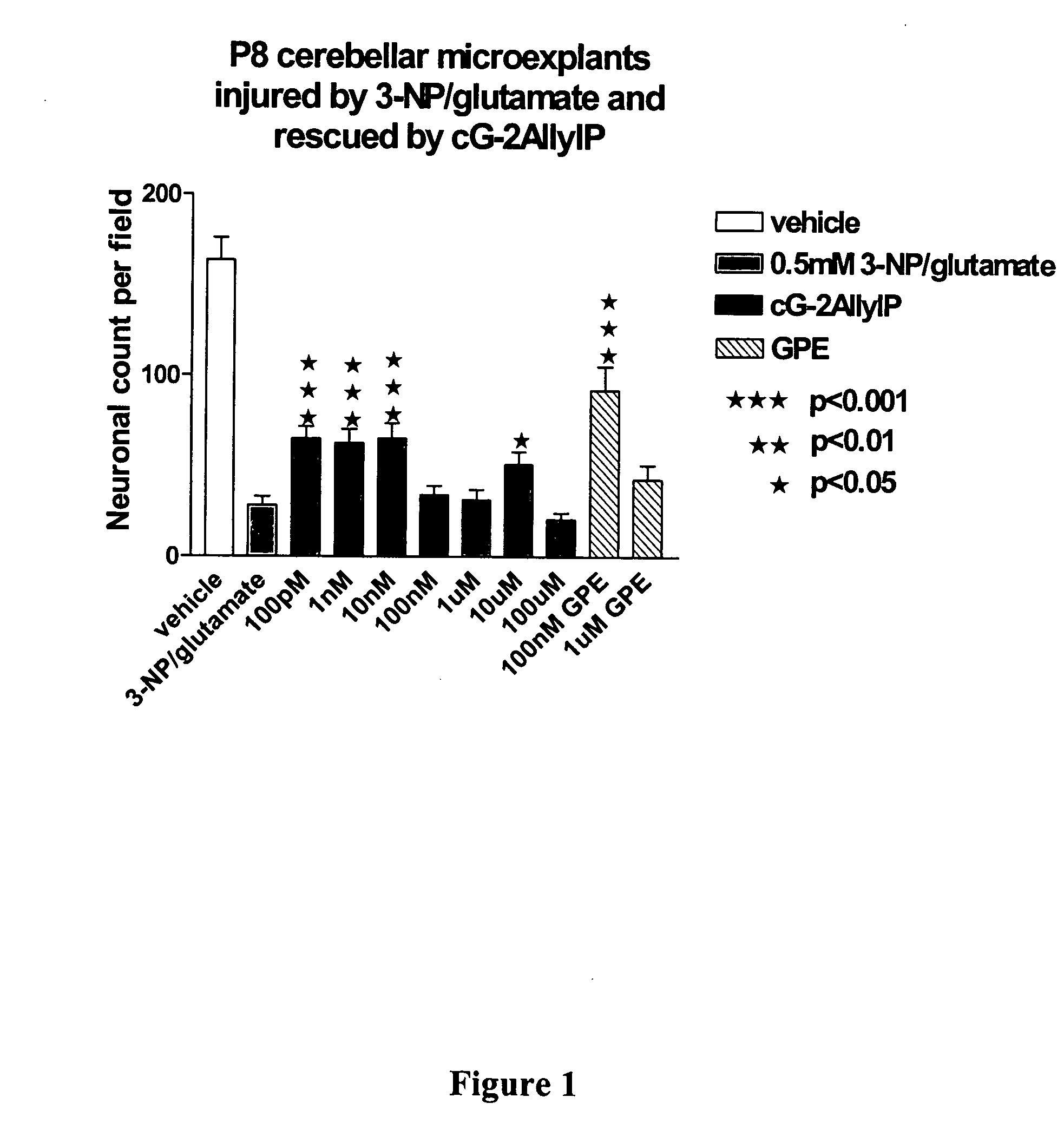Cyclic G-2AllylProline in treatment of Parkinson's disease
a parkinson's disease and cyclic g2allylproline technology, applied in the field of bicyclic compounds, can solve the problems of less effective, nausea, vomiting, postural hypotension, etc., and achieve the effect of reducing tissue damage and preventing neuronal injury
- Summary
- Abstract
- Description
- Claims
- Application Information
AI Technical Summary
Benefits of technology
Problems solved by technology
Method used
Image
Examples
example 1
Synthesis of (8aS)-Methyl-hexahydropyrrolo[1,2-a]pyrazine-1,4-dione (Cyclic G-2MeP)
[0095]
(2R, 5S)-4-Methyl-2-trichloromethyl-1-aza-3-oxabicyclo[3.3.0]octan-4-one 9
[0096] n-BuLi (1.31 M, 4.68 cm3, 6.14 mmol) was added dropwise to a stirred solution of diisopropylamine (0.86 cm3, 6.14 mmol) in dry tetrahydrofuran (10 cm3) at −78° C. under an atmosphere of nitrogen. The solution was stirred for 5 min, warmed to 0° C. and stirred for 15 min. The solution was then added dropwise to a solution of oxazolidinone 8 (1.00 g, 4.09 mmol) in dry tetrahydrofuran (20 cm3) at −78° C. over 20 min (turned to a dark brown colour), stirred for a further 30 min then iodomethane (0.76 cm3, 12.3 mmol) was added dropwise over 5 min. The solution was warmed to −50° C. over 2 h. Water (15 cm3) was added and the solution warmed to room temperature and extracted with chloroform (3×40 cm3). The combined organic extracts were dried (MgSO4), filtered and evaporated to dryness in vacuo to give a dark brown semi-...
example 2
Synthesis of (8aS)-Methyl-spiro[cyclohexane-1,3(4H) tetrahydropyrrolo[1,2-a]pyrazine]-1,4(2H)-dione (Cyclic cyclohexyl-G-2MeP)
[0103]
N-Benzyloxycarbonyl-1-aminocyclohexane-1-carboxylic acid (14)
[0104] To a suspension of 1-aminocyclohexanecarboxylic acid 13 (0.72 g, 5.02 mmol) and sodium carbonate (1.6 g, 15.1 mmol) were dissolved in water-dioxane (21 cm3, 3:1) was added benzyl chloroformate (0.79 cm3, 5.52 mmol) was added dropwise and the solution was stirred at room temperature for 19.5 h. The aqueous layer was washed with diethyl ether (60 cm3), acidified with 2 M HCl and extracted with ethyl acetate (2×60 cm3). The organic layers were combined, dried (MgSO4), filtered and evaporated under reduced pressure to produce a colourless oil, which solidified on standing to crude carbamate 14 (1.23 g, 88%) as a white solid: mp 152-154° C. (lit., 148-150° C.); δH (400 MHz, CDCl3) 1.27-1.56 (3H, m, 3×cyclohexyl-H), 1.59-1.73 (3H, m, 3×cyclohexyl-H), 1.85-1.91 (2H, m, 2×cyclopentyl-H), 2.05...
example 3
Synthesis of (8aS)-Allyl-hexahydropyrrolo[1,2-a]pyrazine-1,4-dione (Cyclic G-2AllylP)
[0107]
(2R, 5S)-4-Allyl-2-trichloromethyl-1-aza-3-oxabicyclo[3.3.0]octan-4-one 17
[0108] n-BuLi (1.31 M, 9.93 cm3, 13.0 mmol) was added dropwise to a stirred solution of diisopropylamine (1.82 cm3, 13.0 mmol) in dry tetrahydrofuran (20 cm3) at −78° C. under an atmosphere of nitrogen. The solution was stirred for 5 min, warmed to 0° C., stirred for 15 min then added dropwise to a solution of pro-oxazolidinone 16 (2.12 g, 8.68 mmol) in dry tetrahydrofuran (40 cm3) at −78° C. over 20 min and the reaction mixture was stirred for a further 30 min then allyl bromide (2.25 cm3, 26.0 mmol) was added dropwise over 5 min. The solution was warmed slowly to −30° C. over 4 h, quenched with H2O (30 cm3) and the mixture warmed to room temperature and extracted with chloroform (3×80 cm3). The combined organic extracts were dried (MgSO4), filtered and evaporated to dryness in vacuo to produce a dark brown semi-solid...
PUM
| Property | Measurement | Unit |
|---|---|---|
| path length | aaaaa | aaaaa |
| temperature | aaaaa | aaaaa |
| temperature | aaaaa | aaaaa |
Abstract
Description
Claims
Application Information
 Login to View More
Login to View More - R&D
- Intellectual Property
- Life Sciences
- Materials
- Tech Scout
- Unparalleled Data Quality
- Higher Quality Content
- 60% Fewer Hallucinations
Browse by: Latest US Patents, China's latest patents, Technical Efficacy Thesaurus, Application Domain, Technology Topic, Popular Technical Reports.
© 2025 PatSnap. All rights reserved.Legal|Privacy policy|Modern Slavery Act Transparency Statement|Sitemap|About US| Contact US: help@patsnap.com



